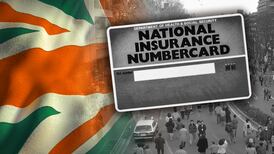The sickening racist and xenophobic violence that took place in Belfast and elsewhere last weekend is unparalleled in modern UK history.
In Belfast, businesses owned by immigrants who have made the city their home were attacked. In England, hotels housing asylum seekers were set on fire, while videos surfaced on social media that showed black people being assaulted in broad daylight by marauding gangs of white men, some of whom performed Nazi salutes for the cameras. “Send Them Back” and other racist graffiti was spray-painted across the front doors of people’s homes.
The rioting was unprecedented in terms of scope. There was unrest in Belfast, the English midlands, the northwest, northeast and in parts of Wales. But there can be little doubt that what happened was the direct result of a long, undignified history of appeasing the far right and normalising racist tropes.
As early as 1919, for example, gangs of white men attacked black passersby and black-owned property in the port cities of Cardiff in Wales and South Shields and Liverpool in England. In Cardiff alone, there was an estimated £3,000 worth of damage done to property – more than £125,000 in today’s money – and three people lost their lives.
RTÉ news boss Deirdre McCarthy: ‘Tackling disinformation has to be much more of a focus now’
Marching practice in a car park with Ireland’s only remaining trade union band
Charm offensive: The close personal encounters with charmers that leave us uneasy
An Irishman in Israel: Is it better for my Israeli daughters to grow up in Tel Aviv or Dublin?
There were similar scenes in Nottingham and London in 1958. Then, as now, the unrest was whipped up by fake rumours spread by the far right. Oswald Mosely, the founder of the British Union of Fascists, was a key player. Just as some far-right figures do today, Mosely hyped up his followers, who in turn attacked black passersby with cries of “let’s lynch them”.
In both cases, rather than oppose the unabashed racism that was behind the riots, the UK government introduced new legislation that was designed to appeal to supporters of the far right. The 1920 Aliens Order aimed to make the lives of foreign-born people so difficult that they would be forced to leave.
Following the 1958 riots, the first restrictions on immigration from Britain’s former colonies in the West Indies, South Asia and Africa were introduced. Significantly, Irish immigrants were exempt from the restrictions. As one official explained to government colleagues, the legislation would “operate on coloured people almost exclusively”.
Last weekend’s violence was primary levelled at asylum seekers and Muslims. Across the UK, police forces scrambled to protect mosques and hotels housing asylum seekers waiting for their claims to be processed. This followed the false rumour spread online that the perpetrator of the knife attack in Southport last week, in which three girls were tragically killed, was a Muslim refugee.
Muslim communities have been subjected to fascist attention for decades. In the UK, a turning point came in summer 2001 when there was another outbreak of racist rioting in northwest England. In cahoots with local football hooligans, far right groups like the British National Party marched through predominately Muslim communities in Bradford, Oldham and elsewhere, and targeted local property.
Just months later, the September 2001 terrorist attacks on New York City shocked the world.
The magnitude of what happened on 9/11 meant that when the UK government report on the 2001 riots was published, its calls for measures to bring about better “community cohesion” soon became indistinguishable from a focus on what was understood to be the need to clamp down on Islamic “extremism”.
In the aftermath of the 2001 riots, the then home secretary, David Blunkett, sought to appease voters who were seemingly gravitating rightward. He reallocated funds that had originally been earmarked for deprived neighbourhoods with large Muslim populations to those constituencies that had voted heavily for the far right.
Blunkett warned South Asian families they risked “schizophrenic” divisions between different generations unless they spoke English at home, and warned of neighbourhoods becoming “swamped” by immigrants.
In the years that followed, hostility toward both Muslims and asylum seekers became even more mainstream. In 2012, Blunkett’s successor as home secretary, Theresa May, unveiled her plan to give asylum seekers “a really hostile reception”. The government’s flagship anti-extremist programme, Prevent, was widely criticised for legitimising Islamophobia.
It is in this period that the seeds for the ill-fated policy of sending UK-based asylum seekers to Rwanda were sowed. And it is surely no coincidence that a version of this policy was first proposed as early as the 1970s in the pages of Bulldog, the magazine of the neo-Nazi National Front.
Amid the chaos and carnage of last weekend, there is cause for hope. In most places, anti-racist protesters far outnumbered the racists. In Belfast’s Lower Ormeau Road area, over 100 residents intercepted a xenophobic parade and chased the racists away with shouts of “Nazis scum, off our streets”. A fundraising page set up to assist the damage that was caused to local businesses raised more than £70,000 in 24 hours.
As the dust settles on last weekend’s shocking violence, there will be people who claim the grievances of those who took to the streets must be heard. But we would do well to learn the lesson from history. Racism is racism, and any attempt to placate it only serves to embolden those who are determined to divide.
Dr Kieran Connell is a Reader in Contemporary History at Queen’s University Belfast. His latest book, Multicultural Britain: A People’s History, is published by Hurst and available to order now.
- Listen to our Inside Politics Podcast for the latest analysis and chat
- Sign up for push alerts and have the best news, analysis and comment delivered directly to your phone
- Find The Irish Times on WhatsApp and stay up to date











